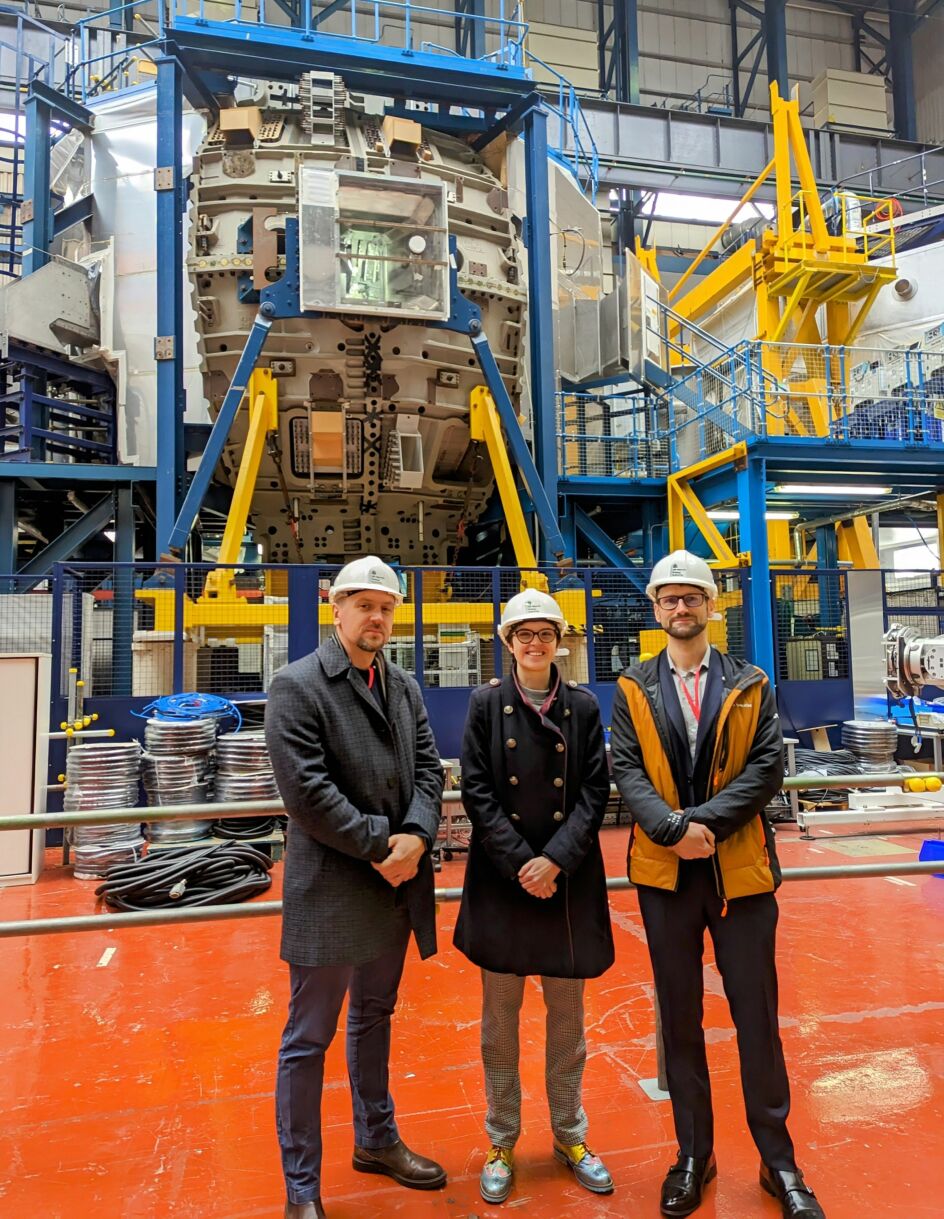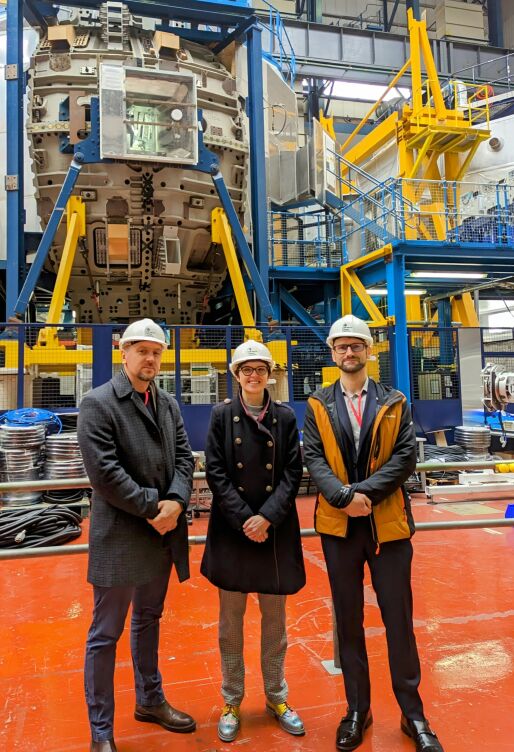Jan Milčák, Managing Director, Director of Reactor Operation Section (CVŘ), Fiona Harden, STEP Hi-CrIS Technical Lead (UKAEA) and Marek Miklos, Business Development Manager (CVŘ)
Fiona Harden, STEP Hi-CrIS Technical Lead for UKAEA, said:
“We look forward to working with CVŘ to build and operate the test rig using their LVR-15 research reactor. The objectives of Hi-CrIS are critical to STEP’s design and this importance is recognised by CVŘ who has worked openly with us to put this agreement in place.”
Marek Miklos, Business Development Manager from CVŘ added:
“Working in partnership with the STEP team is a fantastic opportunity to support the UK’s world-leading programme to develop a prototype fusion energy plant. The Hi-CrIS testing rig will open lots of opportunities for further material studies for fusion applications.”
The Hi-CrIS test rig will have globally unique capabilities, enabling samples to be tested under high energy neutron fluences at cryogenic temperatures and could further develop the knowledge of superconductor components at operating temperatures. Hi-CrIS could also enable alternative materials testing for the potential development of future fusion powerplants.
To find out more about STEP, visit: step.ukaea.uk.
First-of-a-kind test rig will provide critical data for the design and development of Spherical Tokamak for Energy Production (STEP).
The UK Atomic Energy Authority (UKAEA) and Czech Republic research organisation Centrum výzkumu Řež (CVŘ), have signed a multi-year use of facility agreement to enable unique testing of High Temperature Superconducting (HTS) tapes, critical for the development of the UK’s prototype fusion energy powerplant, STEP.
UKAEA will work alongside CVŘ to deliver the first-of-a kind test rig called Hi-CrIS (High neutron fluence Cryogenic Irradiation of Superconductors). The arrangement will collect data on how a neutron spectrum relevant to fusion energy impacts the superconducting properties of the HTS tapes..
STEP plans to use these tapes to confine its fusion plasma, a superheated gas of hydrogen isotopes, in a tokamak. Under intense heat – 150 million degrees celsius, ten times hotter than the core of the sun – and pressure, the isotopes fuse into helium, releasing energy as neutrons.
The Hi-CrIS rig, expected to be operational in 2026, will produce test results for shaping the design and lifespan of STEP’s superconducting magnetic components. These components will function under cryogenic temperatures (20 Kelvin / -253 °C) and be subjected to high flux energy neutrons.
Under the agreement, samples of HTS tapes will be cooled to the same cryogenic temperatures. Maintaining this temperature during irradiation, transportation, and measurement is critical for understanding how the HTS tapes degrade in their operating environment.
The samples will be irradiated with high energy neutrons using CVŘ’s LVR-15 light water tank-type research reactor and kept at 20 Kelvin during transportation and measurement within the rig.

Jan Milčák, Managing Director, Director of Reactor Operation Section (CVŘ), Fiona Harden, STEP Hi-CrIS Technical Lead (UKAEA) and Marek Miklos, Business Development Manager (CVŘ)

Fiona Harden, STEP Hi-CrIS Technical Lead for UKAEA, said: “We are excited to reach this agreement with CVŘ for building and operating a complex test rig using their LVR-15 research reactor. The objectives of Hi-CrIS are critical to fusion powerplant design and this importance is recognised by our partner who has worked openly with us to put this agreement in place.
“We were delighted to host CVŘ representatives at UKAEA’s Culham Campus, promoting the close collaborative approach of both UKAEA and CVŘ to reach our objective, whilst maximising many secondary benefits that this agreement will generate“.
Marek Miklos, Business Development Manager from CVŘ added: “Working in partnership with the STEP team is a fantastic opportunity to support the UK’s world-leading programme to develop a prototype fusion energy plant. The Hi-CrIS testing rig will open lots of opportunities for further material studies for fusion applications.”
The Hi-CrIS test rig will have globally unique capabilities, enabling samples to be tested under high energy neutron fluences at cryogenic temperatures and could further develop the knowledge of superconductor components at operating temperatures. Hi-CrIS could also enable alternative materials testing for the potential development of future fusion powerplants.
STEP aims to demonstrate net energy from fusion and will be built at West Burton in Nottinghamshire, targeting operations in 2040.
Fusion could be transformative for energy supply: near-limitless fuel, low carbon, safe, and sustainable for the long term.
To find out more about STEP, visit: step.ukaea.uk.
First-of-a-kind test rig will provide critical data for the design and development of Spherical Tokamak for Energy Production (STEP).
The UK Atomic Energy Authority (UKAEA) and Czech Republic research organisation Centrum výzkumu Řež (CVŘ), have signed a multi-year use of facility agreement to enable unique testing of High Temperature Superconducting (HTS) tapes, critical for the development of the UK’s prototype fusion energy powerplant, STEP.
UKAEA will work alongside CVŘ to deliver the first-of-a kind test rig called Hi-CrIS (High neutron fluence Cryogenic Irradiation of Superconductors). The arrangement will collect data on how a neutron spectrum relevant to fusion energy impacts the superconducting properties of the HTS tapes..
STEP plans to use these tapes to confine its fusion plasma, a superheated gas of hydrogen isotopes, in a tokamak. Under intense heat – 150 million degrees celsius, ten times hotter than the core of the sun – and pressure, the isotopes fuse into helium, releasing energy as neutrons.
The Hi-CrIS rig, expected to be operational in 2026, will produce test results for shaping the design and lifespan of STEP’s superconducting magnetic components. These components will function under cryogenic temperatures (20 Kelvin / -253 °C) and be subjected to high flux energy neutrons.
Under the agreement, samples of HTS tapes will be cooled to the same cryogenic temperatures. Maintaining this temperature during irradiation, transportation, and measurement is critical for understanding how the HTS tapes degrade in their operating environment.
The samples will be irradiated with high energy neutrons using CVŘ’s LVR-15 light water tank-type research reactor and kept at 20 Kelvin during transportation and measurement within the rig.